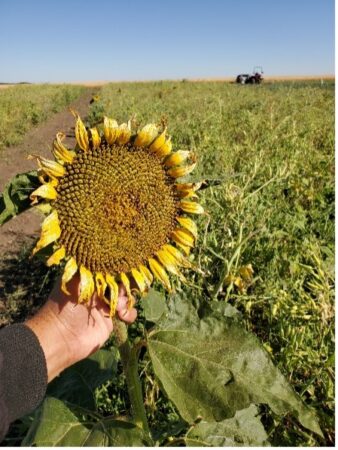
News
Sponsored
Testing innovative cropping systems to mitigate climate variability
Investigating the use of annual cover-crop mixes and their role in improving soil water holding and drainage capacity
March 13, 2023 Sponsored by Battle River Research Group
 Zachary Remillard taking mini-disk infiltrometer measurements. Photo courtesy of Battle River Research Group.
Zachary Remillard taking mini-disk infiltrometer measurements. Photo courtesy of Battle River Research Group.In recent years, producers in Alberta have experienced extreme weather events (excess rainfall and/or drought conditions) and are now recognizing that climate variability will continue to be a challenge to their farming operations. In the annual cropping systems (i.e. grain production) improving soil organic matter can be challenging. No-till systems have largely maintained soil organic matter but have not led to significant increases in soil organic matter. Yet forage producers in Alberta have experienced the benefits of perennial cropping systems in improving both soil water infiltration and organic matter. Producers have thus expressed a need to build more resilient soils in annual cropping systems. Annual cover crops have been suggested as a solution to improve soil water holding and drainage capacity.
It may be the producers who have perennial crops, already inherently know this. In 2019 and 2020 (both wet years for northern Alberta), the only fields that weren’t waterlogged were the hay fields. Everybody just accepts that as a fact of life.
The goal of this experiment was to replicate the benefits of cover crops with annual cover crop mixes that are known to grow well in our area and establish a deep root system.
Grain producers, for example, would not like to put their land under perennial crops (it would be four to five years out of production for them), so that’s why we’re thinking that these annuals may open up the soil and allow for improved infiltration. They may also improve soil organic carbon in soils that are quite low, to begin with. This could solve the main problem with grain cropping systems. Even under no-till, you hit a plateau of (two to three per cent soil organic matter). “We’d like to see them get to four to five per cent soil organic matter. Then we’d have very resilient soils,” says Lance Ouellette, manager with North Peace Applied Research Association.
Therefore, a new project initiative was begun, led by three farmer-led research groups in the province, North Peace Applied Research Association, Battle River Research Group and Gateway Research Organization.
The experiment was designed with the following method. The annual deep-rooted cover crops mixtures composed solely of brassicas versus mixtures composed of brassicas along with cool season and warm season crops were laid out in thirteen treatments. In this way, this study also evaluates whether polycultures (mixes) can improve crop water supply compared to monocultures. Most studies have shown that the extent to which cover crops improve soil properties depends on their ability to produce high below-ground biomass. Spring-seeded cover crops offer the advantage of a full growing season, and species selection is imperative for optimizing below-ground biomass production.
The sites were established at three different locations in various climatic and soil zones of Alberta. Soils were tested for organic matter and available water capacity through two double-ring and mini-disk infiltrometer methods.
This study targeted both field crop and livestock production systems in Alberta. Livestock producers currently have more incentive to adopt spring-seeded cover crops, because they can graze them during the growing season and/or use them to extend their grazing season in the fall. This study aims at providing additional evidence for field crop producers to adopt cover cropping practices.
The goal would be to give another incentive to grain producers to grow these annual cover crop mixes. Especially on marginal land that doesn’t drain well.

Project site at BRRG.
The economic benefit is anticipated to be towards the main field crop (grown in years two and four of this experiment), where yields will likely increase because of improved soil water holding and/or drainage capacity. The yield response will be dependent on which cover crop mixes are tested, and how much below-ground biomass is produced. The cost-benefit analysis will also reflect the forage value from the cover crop.
The environmental benefit is anticipated to be linked to improved water holding and drainage capacity. In finer textured soils, periods of excess rainfall often lead to ponding. Anaerobic conditions in these ponds, lead to denitrification. Conversely, in coarser textured soils, excess drainage may lead to nitrate leaching. The project will run for four years, the results will be showcased in our annual reports, field tours, newsletters and social media posts.
Acknowledgments: The research is funded by Results Driven Agriculture Research.